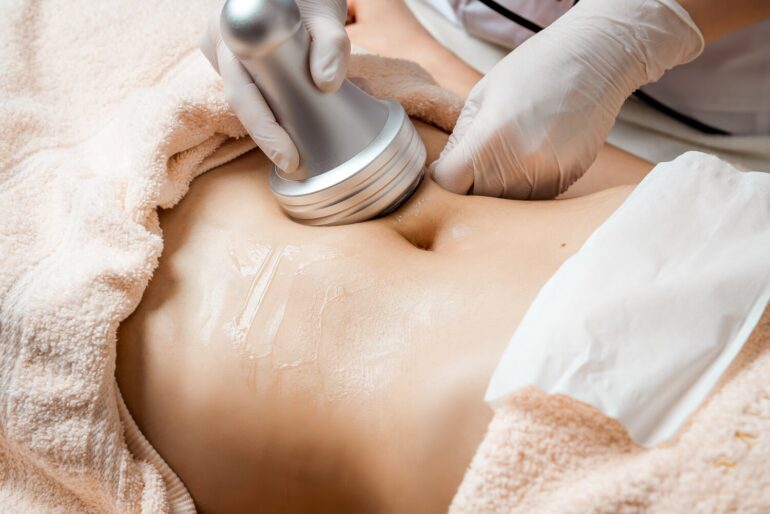Ultrasonic cavitation is a nonsurgical fat deduction procedure that has received FDA approval. It is also known as ultrasound cavitation, fat cavitation, ultra cavitation, and cavi lipo. This procedure employs ultrasound waves to kill fat cells in the tummy, upper arms, love handles, chin, or thighs.
Cavi Lipo is frequently promoted as an alternative to liposuction for body sculpting. However, different from surgical lipo, which can achieve optimal results with just one technique, you will require several (up to 12) ultrasonic cavitation sessions to get noticeable effects. You will need to wait about three months for your lymphatic system to wash out the dead cells prior to seeing the ultimate results.
Though it is not a quick remedy, this type of body contouring has additional benefits. Every ultrasonic cavitation session is fast as the provider slides the cavitation machine’s portable probe over the specific area for about an hour, providing low-frequency sound waves that vibrate the fat cells’ walls until they rupture and change into free fatty acids that the body can eliminate.
The procedure is painless and needs slight or no recovery time. In addition, the risks are low, and side effects are uncommon. You can check out this guide to learn more about ultrasonic cavitation.
How Ultrasonic Cavitation Works?

Ultrasound technology is used in ultrasonic cavitation to disperse fat cells. Ultrasound waves penetrate deep into your skin’s layers, generating a jarring vibration. Fat cells separate from one another and fall out of your dermal layers.
The fat cells are consumed by the lymphatic system and discharged as waste from your body after some days. Though it is impossible to say how successful this treatment is, a recent study suggests it is relatively beneficial. A study conducted in 2019 looked at the effects of ultrasonic cavitation on 50 women who were medically heavy.
The low-calorie diet was followed by 50 percent of ladies, while the other 50 percent combined it with radiofrequency and ultrasound body sculpting methods. The females who received ultrasonic cavitation demonstrated a reduction in body fat mass in about five weeks. What’s surprising is that they did not lose any more weight compared to the other group, but they did drop body fat.
A smaller research conducted in 2007 followed 30 people who had all received ultrasonic cavitation body contouring treatment. After three treatments, all of the participants had lost weight. At the end of the research, the treated body fat area had shrunk by one to three centimeters. This study also revealed that people did not lose weight but rather fat.
If you want to buy an ultrasonic lipo cavitation machine, make sure to check out https://lumbuy.com/professional-ultrasonic-lipo-cavitation-machine/ where these machines are accessible in varying models and different price ranges.
What To Do Before Ultrasonic Cavitation

Your provider will inform you of specific instructions to help you prepare for your appointment. Make sure to follow them carefully. Before your appointment, it is best to tell your provider the following:
- Medical situations you have (if any)
- You use any herbal supplements or medications that you have been using for a while.
- Make sure to avoid alcohol for a minimum of 48 hours prior to your consultation.
In the two weeks coming up to your procedure, you might be recommended not to use nonsteroidal anti-inflammatory medicines (NSAIDs) like ibuprofen. It is best to drink more water prior to and after your treatment, which will help your body remove fat deposits swiftly.
Ultrasonic cavitation is a rather basic operation. Based on the region of your body being treated, the doctor may inform you to undress in a changing area and wear a paper gown on the day of your appointment.
The doctor will use alcohol to disinfect the treatment area. They will gradually go over the target area of your body with the help of handheld ultrasound equipment. During the operation, you might feel warm and hear a buzzing sound from the ultrasound equipment. Treatments last anywhere from 40 minutes to an hour.
What To Anticipate After Ultrasonic Cavitation

You should be capable of standing and driving after getting the ultrasonic cavitation procedure. Bruising and pain are generally minor. After the treatment, you will be told to drink as much water as possible to enable your body to drain the fatty cells through your lymphatic system. However, do not anticipate immediate results. In addition, your body may feel puffy or swollen following your appointment.
The fat cells that have been displaced require time for your body to pull apart and disappear. Frequent treatments are necessary in order to notice noticeable benefits. The majority of people who receive this treatment can recognize their ultimate results in about 6 to 12 weeks.
Treatment usually takes 1 to 3 visits to see visible benefits. As long as you eat well and exercise regularly, the effects of this treatment will last. However, if you live an inactive lifestyle, fat deposits in previously treated areas may resurface.
Ultrasonic Cavitation Results

Your full results should occur three months following your last treatment session. However, the speed with which they appear is determined by how well your body’s lymphatic system removes the damaged cells.
The elimination process starts immediately. In addition, drinking more water, eating healthy food, and exercising on a regular basis can all assist in speedy results. Fat cells are killed for good after they have been eliminated. As a result, the results are permanent.
If you maintain a healthy weight, the results will last for many years. However, the fat increase is linked to age, hormones, and other factors. In order to protect the remaining fat cells in the area from increasing with weight gain, you have to maintain a balanced diet and exercise consistently.
Bottom Line
The ultrasonic cavitation procedure is painless and helps you lose body fat instead of body weight. If you want to try a fat loss method without many side effects and slow results, this procedure is the best option.
